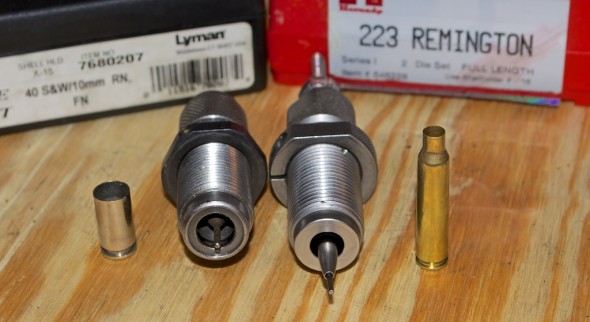
A .40 S&W resizing die (left) Note the carbide ring. The .223 Remington resizing die on the right has the decapping rod extended to show the case mouth expander ball.
Every time you pull the trigger, lot’s of violent things happen inside the chamber of your gun.
- The primer ignites.
- The primer ignition sets flame to the propellant, which then begins to burn at an obscenely fast rate. It doesn’t technically explode (unless you’re using black powder) but it burns so fast you might think it’s exploding.
- As the propellant burns, the chemical reaction creates high pressure gas, which has to go somewhere – fast.
- This swelling gas cloud inside your cartridge does two things. First, it expands the brass cartridge case until it’s pressing against the inside walls of the gun’s chamber. Then, it pushes the projectile hard enough to overcome the friction of the cartridge case mouth and launch it down the gun barrel.
- As the bullet leaves the cartridge, and the pressure starts to drop, the brass cartridge case starts to shrink back closer to it’s original size – but not all the way.
- The cartridge case mouth will be opened up a bit as a bullet that was comfortably seated there has just been violently ejected.
All of this happens in a split second and is the reason that, when reloading your own ammunition, you need to resize the brass cartridge case using a resizing die. While resizing the cartridge case rarely compresses it to it’s original size, it will crush it back within cartridge dimension standards, allowing it to chamber in any gun of the proper caliber.
Resizing Dies
A resizing die is simple a carefully shaped hunk of metal that is used to “press” the empty cartridge case back to standardized dimensions. The brass cartridge case is forced into the interior of the die with a reloading press and the internal shape of the resizing die presses the brass back into the proper dimensions.
Think of this process as making a hamburger. You take a misshapen pile of ground beef, and using pressure from the outside, you shape it into the desired form. With fired brass, you take a cartridge case that has contained a massive conflagration, and therefore expanded in size, and press it back into shape. Unlike the hamburger, brass is hard, and tastes lousy, hence the need for a steel resizing die and a reloading press to apply the necessary pressure.
Brass is not as easy to “work” as hamburger meat, and significantly more pressure than available with bare hands is required to reshape it to standard size. Squashing a brass case into a steel hole under great pressure will almost certainly result in a unified piece of useless steel-brass metal as two parts are hopelessly stuck. Why? Unlike hamburger meat, neither brass or steel have yummy, slippery fat grease naturally available. So, when resizing brass, you need to have some type of lubrication.
Depending on the type of cartridge you’re resizing, this can be done in a couple of different ways. Let’s talk about how that’s handled in both straight wall and bottleneck cartridges.
Pistol Brass (Straight Wall Cartridges)
By “straight wall” I simply mean that the cartridge case is shaped like a cylinder that has the same diameter from the rim of the cartridge to the mouth. Like a toilet paper roll or aluminum soda can. Not all pistol cartridge cases are like this. A great example of an exception is the .357 Sig, which is shaped more like an old Coke bottle as it narrows as you get closer to the case mouth. In these rare cases, you need to resize it as you would a bottleneck rifle cartridge. We’ll get to that in a minute.
Even though most pistol cartridges have straight walls and resizing is minimal, lubrication is still required. This is where ingenuity comes into play. Some clever reloading engineer figured out that carbide is a little more slick than standard steel. If you could make a reloading die out of carbide, then additional lubrication would not be required, as the brass case won’t stick to the carbide material. Most reloading dies for straight walled cartridges have a carbide ring. As you pass the “ring” down the length of the cartridge case, it resizes as it goes – without grease.








[…] Squashing Brass: The Basics Of Resizing Rifle And Pistol Cartridge Cases is an article from: My Gun Culture – A humorous look at guns and shooting – Learn with a laugh! Your resource for gun reviews, shooting tips, personal defense, holsters, competition, shooting industry news and Second Amendment issues […]